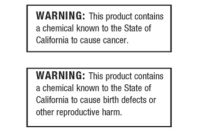Category: Chemicals
Today’s workplace uses thousands of chemicals, many of which are hazardous. The resources in this section will help guide you in the safe and legal identification, storage, transport, and use of these chemicals, and in making sure that your employees right to know how to be safe around such substances is provided, as required by law.
In its Per- and Polyfluoroalkyl Substances (PFAS) Action Plan, released in February 2019, the EPA noted that in 2018, it initiated the regulatory development process for listing the two most problematic PFAS—perfluorooctanoic acid (PFOA) and perfluorooctane sulfonate (PFOS)—as hazardous substances under the Comprehensive Environmental Response, Compensation, and Liability Act (CERCLA or Superfund).
The EPA has released what it describes as the first update of the Toxic Substances Control Act (TSCA) Inventory in 40 years. The update indicates that 47 percent of the 86,228 chemicals listed on the Inventory are “active,” which means they have been manufactured, processed, or imported for a nonexempt commercial purpose during the 10-year […]
With considerable fanfare, including news conferences in every EPA region, the Agency unveiled its Action Plan for per- and polyfluoroalkyl substances (PFAS), a large class of manufactured chemicals that have proven to be highly effective in many industrial applications and have also spread risks to human health through sources of drinking water across the nation. […]
It is not a stretch to say that the 2016 amendments to the federal Toxic Substances Control Act (TSCA) were motivated to a large extent by the EPA’s inability under the law to ban, or at least significantly restrict, industrial and commercial uses of asbestos. Under new authority provided in the amendments, the Agency promptly […]
The Tier II hazardous chemical inventory reporting deadline is quickly approaching. Are you prepared to submit your report by March 1st?
In January 2017, the EPA amended its regulations affecting the certification of applicators of restricted use pesticides (RUPs). In writing the amendments, the Agency needed to balance two somewhat opposing forces—strengthen requirements to ensure that applicators and particularly young applicators, as well as the families of applicators, were not harmed by exposure to RUPs while […]
Employers must comply with several sets of federal environment, safety and health laws and regulations. OSHA has outlined where federal pesticide labeling requirements end and where hazard communication requirements begin and where the two overlap.
OSHA is expected to revise its Hazard Communication (HazCom) Standard this year to bring it in line with the current Globally Harmonized System (GHS) of Classification and Labeling of Chemicals and formalize various enforcement policies that have been issued since the last major update to HazCom in 2012. Employers that manufacture, import, distribute, or use […]
Since it was introduced in 1986, California’s Proposition 65 (Prop 65, shorthand for the state’s Safe Drinking Water and Toxic Enforcement Act of 1986) has regularly broken new ground on ways government can compel businesses to warn the public about the dangers of chemicals in products, structures, and the environment. Here we will summarize Prop […]
On January 18, 2019, one day after the Department of Homeland Security’s (DHS) Chemical Facility Anti-Terrorism Standards program (CFATS) was scheduled to expire, President Trump signed a bill that provided the program 15 months of new funding. News of the extension provides an opportunity to review one of the more unusual aspects of the CFATS […]










